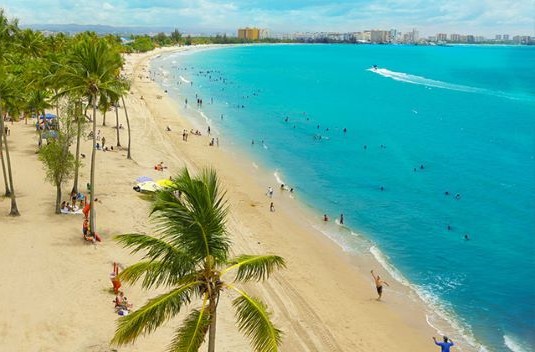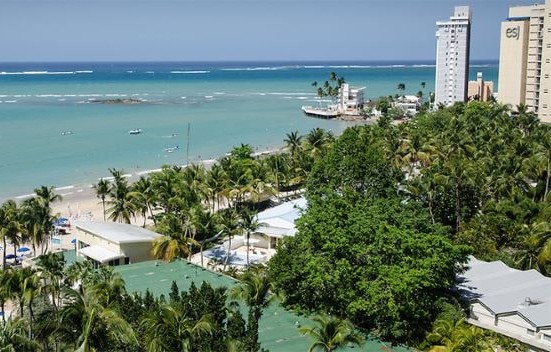The History of Isla Verde Beach and Its Surroundings

Framed by pale-gold sand and turquoise surf, Isla Verde Beach sits at the eastern edge of metropolitan San Juan in the municipality of Carolina. Today it’s renowned for wide public shorelines, high-rise hotels, and a lively dining scene, yet the area’s easygoing glamour rests on centuries of coastal change—both natural and human. From mangrove-fringed inlets and fishing paths to a mid-century resort boom and modern Blue Flag stewardship at the Balneario de Carolina, Isla Verde’s story is one of water shaping a city’s front yard.
Before the Hotels: A Shore of Reefs, Inlets, and Dunes
Long before boardwalks and beach umbrellas, the Isla Verde shoreline was a mosaic of dunas (sand dunes), sea grape thickets, and shallow reef fingers that softened Atlantic swells. To the east, the mouth of Boca de Cangrejos connects the ocean to lagoons and mangrove channels—nursery waters for fish and feeding grounds for birds. These natural features still define the beach’s character: calm sections form where reefs interrupt the waves, while wind-sculpted dunes protect the backshore from storms. Even now, seasonal conservation zones appear on quieter stretches to safeguard nesting sea turtles, a reminder that the beach is not just a playground but a living habitat.
Carolina’s Coastal Villages and the Pull of the Sea
As Puerto Rico’s coastal settlements grew, fishermen and salt-marsh harvesters favored these gentle entries to the sea. Trails linked the shore to inland parcels where small farms and later suburban neighborhoods developed. The ocean was both larder and highway—delivering catch, coconuts, and commerce. The beach’s generous width and firm sand made it a natural promenade, a place to dry nets, gather families, and watch incoming weather. This everyday intimacy with the sea laid the groundwork for later recreation: when roads improved and cars multiplied, the same qualities that suited workdays also suited weekends.
Aviation Arrives: Gateway Next Door
Mid-century aviation reshaped Isla Verde’s destiny. The island’s primary airport rose just inland, and jets brought new travelers, faster. With the runway minutes from the surf, the neighborhood became Puerto Rico’s “front porch” for visitors. Developers saw opportunity in the trifecta of airport + beach + sunshine, and hospitality followed: seaside hotels, modern apartment towers, and palm-lined avenues designed for strolling between lobbies, cafés, and the waterline. The proximity to flights also knit Isla Verde to the broader Caribbean, inviting chefs, musicians, and entrepreneurs whose influences still flavor the district’s rhythm.
The Resort Boom and Urban Beach Culture
In the 1950s–1970s, Isla Verde blossomed into a quintessential urban beach. Architecture embraced breeze blocks, shaded porticoes, and glassy views; pool decks merged with ocean horizons; live bands and ballroom nights gave the neighborhood a festive pulse. Beach clubs introduced sailing lessons and catamaran rentals, while outfitters taught surfing on the sandbar breaks near Punta Las Marías to the west. Daylight hours revolved around sun and water; evenings turned to supper clubs, salsa, and casino lights. Crucially, public access remained a signature feature: even as towers climbed, wide public sections of sand kept the shoreline democratic and energetic.
Balneario de Carolina and the Rise of Stewardship
As tourism matured, so did environmental standards. The Balneario de Carolina—the official public beach complex within the Isla Verde strand—invested in lifeguards, accessible walkways, water-quality monitoring, and dune restoration. Earning Blue Flag recognition signaled a commitment to safety and sustainability: clean restrooms, maintained facilities, and clear swimming advisories became part of the beach’s identity. These efforts didn’t just win awards; they preserved the very qualities that drew people here in the first place—clear water, stable sands, and family-friendly amenities.
Culture at the Water’s Edge
Isla Verde’s history is also cultural. To the east, the coastal community of Piñones and nearby Loíza carry deep Afro-Puerto Rican traditions, from bomba rhythms to culinary staples like alcapurrias and bacalaítos. Weekenders often pair a swim in Isla Verde with a taste tour of the kiosks—an edible heritage that anchors the area’s sense of place. Festivals, beach volleyball tournaments, and surf events keep the shoreline social, while sunrise workouts and sunset strolls give residents daily rituals that bind neighborhood to sea.
Ecology in a City Setting: The Isla Verde Reef
Though urban, parts of the nearshore form a sheltered reef-lagoon environment. Seagrass patches and coral heads host juvenile fish and shy invertebrates; on glassy days the water can turn aquarium-clear. Community groups and dive operators periodically organize cleanups and coral-gardening projects, reminding visitors that small habits—avoiding trampling, packing out trash, using reef-safe sunscreen—scale up to real protection. Storms have always been part of the story, but healthy dunes and reefs help the coast rebound between swells and seasons.
Walking the Timeline Today
A modern visit can read like a time-lapse. Start on the broad sands of the Balneario, where lifeguard towers and wayfinding reflect contemporary beach planning. Wander west past high-rise silhouettes—mid-century optimism translated into glass and balconies—and watch kites trace the trade winds over the surf. Turn east toward Boca de Cangrejos to glimpse the mangrove edge that predates the hotels. If the schedule allows, hop over to Piñones for a fritura crawl that links today’s beach day to generations of coastal cooks. In each direction, the layers stack: ecology, neighborhood, airport era, and resilient public space.
Why the Past Matters for the Next Tide
Understanding Isla Verde’s history clarifies the work of keeping it special. The dunes aren’t just pretty—they’re protective infrastructure. Lifeguards and Blue Flag protocols aren’t just amenities—they’re part of a civic compact that keeps the beach welcoming for everyone. And the towers on the skyline tell a story of openness to the world that began when airplanes stitched Puerto Rico into global travel. When you spread a towel here, you borrow from all those chapters. Care for the place as earlier generations did—respect the water, share the sand, and savor the culture—and Isla Verde will continue to feel effortlessly glamorous: a living shoreline where the island meets the world with a smile.
Tip: Arrive early for calmer water and gentler light on the dunes, and bring a mask on clear days to peek at the nearshore reef life that helped shape Isla Verde’s famously swimmable surf.


